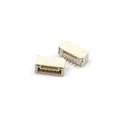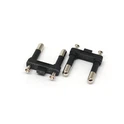A DC connector (or DC plug, a common connector) is an electrical connector used to provide DC (DC) power.
Compared with domestic AC plugs and sockets, DC plugs have more specifications and models, and cannot be replaced. In order to avoid incompatible power supply and accidental interconnection of loads, the size and arrangement of DC connectors can be selected. There are many kinds of them, from small coaxial connectors for supplying power from AC adapters to portable electronic devices to battery assemblies in automobile accessories and portable devices.
At present, there are a large number of PCB power plugs, such as molexmini fitsr, molexmini fitjr, molexmicrofit, molexsaber connectors, and ampduac connectors.
Some three, four, five or more needles are also called direct current needles. These are commonly used in vacuum tube devices and can provide various voltages. For the sake of safety, in the vacuum pipe device, the pin is generally arranged on the side of the connecting device.
Many mobile phones use DC plugs, which are special for manufacturers or even special. In order to improve the interoperability of mobile phone chargers, major manufacturers have reached an agreement to use small USB interfaces for new mobile phone chargers since 2010.
Many manufacturers manufacture special DC power connectors for battery packs, instruments, medical equipment, communication equipment and other equipment.
The battery of PowerPack (PP) (such as PP3 nine volt type) has ring-shaped and hexagonal terminals and can be connected with "snap" connectors (which are physically the same, but have opposite polarity).
A special "octal" plug, 8 or 11 pins, similar to octal plugs or tube sockets, is used to connect power to certain tube audio amplifiers, transmitters and transceivers (especially in an amateur radio model). The power supply is equipped with a main socket, and the radio is equipped with a plug (with exposed pins). It is also convenient to provide paired connecting wires. These connections carry anode positive voltage (typical hitkitt 600 VDC, Collins 800 VDC), grid negative bias (- 130 VDC), 6.3 to 12.6 VAC heater (filament), and control (remote power switch).






